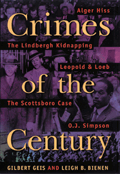

|
 |
|

|
Climb the backstairs of the University President's house and you find
a third-floor ballroom, Leigh Buchanan Bienen's home office. Fiction
writer, dramatist and lawyer, she has refinished the floors and
painted the walls, making the once-deserted space sparkle. A half-
dozen worktables, heaped with books, testify to the orderly chaos of
her many activities and commitments. Although weary after a day of
teaching downtown at the Northwestern University School of Law,
she retrieves copies of literary magazines and law journals, preludes
to Crimes of the Century (Northeastern University Press, 1998), her
most recent book. Bienen's legal scholarship and literary talent create a page-turning narrative. She and her co-author, criminologist Gilbert Geis, bring to life five controversial trials of the 20th century. Each case is staged like a one-act play. Before the curtain rises, we're given a précis - the plot and the dramatis personae. We delve into the crime: the police investigation, the evidence, the character of the accused, the issues of race and class, the biases of judges and the news media frenzy. A variety of role players battle for the public's sympathy - Clarence Darrow, Richard Nixon, Alger Hiss, Charles Lindbergh, Johnnie Cochran and Marcia Clark. And the outcome of each trial hinges on the complexities of the law, the resources of the defendant and the public's lust for punishment and revenge. "These cases," says Bienen, taking a moment to pour tea, "were crucibles of the history of their times. They became causes célèbres, great moral causes." In the book are child murderers Leopold and Loeb from 1924; the Scottsboro Boys, young black men unjustly accused of rape in Alabama in 1931; Bruno Richard Hauptmann, convicted in 1935 of kidnapping the Lindbergh baby three years earlier; Hiss, convicted of perjury in 1949, following relentless pursuit in Congress by a young Nixon; and, of course, the O.J. Simpson trial from 1995. Four of the five cases involved capital charges. Lives were at stake. Fascism, anti-Semitism, racism and Communism provided the stage setting for these fevered, national dramas. And still the cases show traces of surprising timeliness. What is the Hiss case about, after all, but an important public figure who is prosecuted for lying to a grand jury? When asked why the authors chose these trials, Bienen answers that it was in some measure because of her family. Her father, an economics professor at the University of California, Berkeley, lived through the controversy of the California loyalty oath. So the Hiss case was personally, as well as legally, captivating. "And I was interested in Hauptmann because my first capital case was tried in the same courtroom where Hauptmann was sentenced to death," she says. "The Hauptmann trial was unjust. The trial did not protect the rights of the defendant, whether he was innocent or not, and neither did the appeal process. The courts did not do their job." Part of her purpose is to persuade us that the courts can, and should, do better. In the weeks after Lindbergh's son was kidnapped, the family received 38,000 letters. Lindbergh, rich and famous, assumed control of negotiations, which dead-ended after ransom money was passed on April 12, 1932, in a Bronx cemetery to a man with a foreign accent. Two years later, serial numbers on the greenbacks led police to Hauptmann, a German-born carpenter. Despite the man's alibi, the prosecutor, New Jersey Attorney General David T. Wilentz, arraigned Hauptmann on charges of felony murder without ever specifying the nature of the felony. Every day, jurors, sequestered at a hotel, ran the gantlet of a crowd chanting "Burn, Bruno, burn." Horror-struck by the discovery of the child's corpse, half-clothed and partially devoured by animals, the public put enormous pressure on the criminal justice system to exact revenge. Like a novel, each case begins dramatically. After a dozen white men complained to the stationmaster in Stevenson, Ala., that a group of blacks had thrown them off a train, a hastily deputized posse of 50 men stopped a Great Southern Railroad freight hauler in nearby Paint Rock on March 25, 1931, and arrested all the black males on it, ages 13 to 20. Quotes from the defendants capture their desperation. One, Haywood Patterson, wrote, "Color is more important than evidence down here. Color is evidence. Black color convicts you. A light Negro stands a better chance in court than a real black one like me." The cases dragged on for years, with one or more of the defendants being sentenced to death repeatedly. Finally, in 1950, the last of the Scottsboro Boys was paroled, but the lives of all of them were shattered by their unwarranted imprisonment. The country's mood, and the criminal justice system, had changed considerably by the time of the O.J. Simpson trial. "The dramaturgy of the Simpson trial itself, and the not-guilty verdict, told a very different story about race relations and criminal justice in America from the one that had unfolded more than half a century earlier in Scottsboro," write Bienen and co-author Geis. Still, the fact of a mixed-race marriage had much to do with the public's fascination with the Simpson trial. "I was teaching a class on juries at the time the verdict was handed down," Bienen says. "If the Simpson case hadn't been black/white, it wouldn't have generated the same level of interest. But in comparison with Hauptmann and Scottsboro, the criminal justice system was much improved by the time of Simpson." Each of these "crimes of the century" changed the legal system. After the Scottsboro trial, a conservative Supreme Court extended the protections of the 14th Amendment, in part, to "protect black people from oppression," according to Bienen. She believes this was a "monumental step toward increasing fairness in criminal proceedings." Bienen doesn't just pin the blame on the police. "Society asks police to do a difficult job, like soldiers. The job of the police is to get convictions," she says. "They have to deliver suspects that a prosecutor can convict. Everything in the system is driving toward conviction, and that starts at the time of the arrest. Prosecutors assume you're guilty when you're arrested. But the legal system and the courts must redress the imbalance and act as a check. Otherwise, you end up with innocent people being convicted and sentenced to death." Last November, Bienen spoke at a Northwestern law school conference on the wrongfully convicted. Since 1976, more than 500 people have been executed in the United States. In that same period, 74 people who were sentenced to die have been exonerated and released from death row. Some were imprisoned for decades. Asked about the best way to protect the rights of the accused, Bienen responds, "The Bill of Rights needs constant oversight." Then she adds, "I'd like to get rid of the death penalty. Whatever its ideals, the criminal justice system, when pressed, is too likely to adjust its ways to mollify public outrage." That was true in the 1920s, and it's true today, Bienen concludes. That's the take-home lesson in Crimes of the Century. Marylee MacDonald is a freelance writer based in Evanston.
|